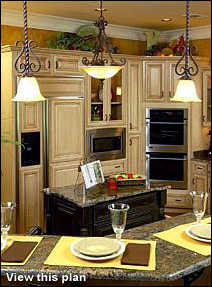Energy-Efficient Home Lighting

The most common home light source is the pear-shaped incandescent light bulb, but as homeowners seek to make their homes more energy efficient these classic bulbs are getting pushed out of the limelight in favor of compact fluorescent lights (CFLs) and LEDS.
The incandescent light bulb may be the least expensive to buy, but it is the most expensive to operate. For example, they use three to four times more energy to produce the same amount of light as a fluorescent lamp; last only one-tenth the life of a fluorescent; and use 15% of energy for light while 85% of the energy becomes heat.
Besides costs, your choice of lighting also affects the comfort, security and convenience of your home, so when you begin building and designing the interior of your new home you should take into consideration using only energy efficient lighting like CFLs, and LED. All of these light sources are more energy efficient and longer lasting than incandescent lights.
When it comes time to choose your home lighting, it is important that the CFL matches the right kind of fixture to ensure that it will perform properly and efficiently.
Here are some helpful tips and guidelines when shopping for a CFL for your new home:
- CFLs are best suited for open fixtures that allow airflow, such as table and floor lamps, wall sconces, pendants, and outdoor fixtures. Be sure to protect your outdoor fixtures from moisture.
- You'll want to use CFLs in fixtures that are on for three or more hours a day. These are generally areas that are high-traffic like the kitchen, living room, bathroom and outdoors.
- For recessed fixtures, a reflector CFL works better than a spiral CFL because the design of the reflector allows even distribution of light to your task area.
- Select dimmable bulbs for use with dimmer switches because not all CFLs are suitable for use with dimmer switches.
- Check the size of your light fixtures so you purchase the correct bulb size. CFLs come in a wide range of sizes, shapes and wattages.
- Different light bulbs emit different colors of light, be sure to pick the right shade for your lighting needs.
- Look for the ENERGY STAR label for products that meet or exceed the government energy efficiency standards.
- To choose the ENERGY STAR qualified CFL with the right amount of light make sure you read the label to ensure it's equivalent to the incandescent bulb you are replacing. Light bulb manufacturers include this information right on the product packaging to make it easy for consumers to choose the equivalent bulb.
- You should check the lumen rating to find the right CFL. The higher the lumen rating, the greater the light output.
- Recessed ceiling lights can cause air to leak from attic spaces and increase heating and cooling costs. Be sure to ask your builder or electrician to use recessed fixtures that minimize air leakage or other alternatives such as track lighting or wall wash fixtures.
LED (light emitting diode) lighting has been around since the 1960's but only recently has it become a more affordable and efficient alternative for residential lighting design. Compared to incandescent and CFLs, they are very effective at placing light in a single direction.
Here are some ideal applications for led lighting in your new home:
- Reading and task lighting
- Strip lighting (under furniture)
- Safety and ambiance for outdoor and landscape lighting
- Low-level lighting, like stairways
- Back lighting (secondary lighting schemes)
The advantages of led lighting are they consume very little energy, last over 25 thousand hours, are environmentally safe (no mercury), come in a wide range of colors and are highly durable for indoor and outdoor use.
Some of the disadvantages to using led lighting are they are more expensive than conventional light sources, they have a narrow beam so they aren't very effective as your primary light source and they are heat sensitive.

 The most common home light source is the pear-shaped incandescent light bulb, but as homeowners seek to make their homes more energy efficient these classic bulbs are getting pushed out of the limelight in favor of compact fluorescent lights (CFLs) and LEDS.
The most common home light source is the pear-shaped incandescent light bulb, but as homeowners seek to make their homes more energy efficient these classic bulbs are getting pushed out of the limelight in favor of compact fluorescent lights (CFLs) and LEDS.